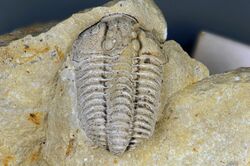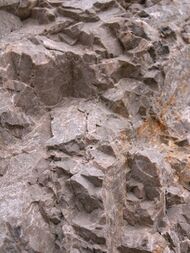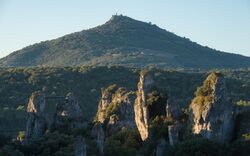Earth:Dolostone

Dolostone or dolomite rock is a sedimentary carbonate rock that contains a high percentage of the mineral dolomite, CaMg(CO3)2. In old USGS publications, it was referred to as magnesian limestone, a term now reserved for magnesium-deficient dolostones or magnesium-rich limestones. Technically, dolostone has a stoichiometric ratio of nearly equal amounts of magnesium and calcium. Most dolostones formed as a magnesium replacement of limestone or lime mud prior to lithification.[1] It is resistant to erosion and can either contain bedded layers or be unbedded. It is less soluble than limestone in weakly acidic groundwater, but it can still develop solution features over time. Dolostone can act as an oil and natural gas reservoir.
The term dolostone was introduced to avoid confusion with the mineral dolomite. The usage of the term dolostone is controversial because the name dolomite was first applied to the rock during the late 18th century and thus has technical precedence. The use of the term dolostone is not recommended by the Glossary of Geology published by the American Geological Institute. It is, however, used in some geological publications.
The geological process of conversion of calcite to dolomite is known as dolomitization and any intermediate product is known as "dolomitic limestone."[2]
The "dolomite problem" refers to the vast worldwide depositions of dolostone in past geologic record eluding a unified explanation for their formation.
The first geologist to distinguish dolomite rock from limestone was Belsazar Hacquet in 1778.[3]
Caves in dolostone
As with limestone caves, natural caves and solution tubes can form in dolomite rock as a result of dissolution by weak carbonic acid.[4][5] Calcium carbonate speleothems (secondary deposits) in the forms of stalactites, stalagmites, flowstone etc, can also form in caves within dolomite rock. “Dolomite is a common rock type, but a relatively uncommon mineral in speleothems”.[4] Both the 'Union Internationale de Spéléologie' (UIS) and the American 'National Speleological Society' (NSS), extensively use in their publications, the terms "dolomite" or "dolomite rock" when referring to the natural bedrock containing a high percentage of CaMg(CO3)2 in which natural caves or solution tubes have formed.[4][6]
Dolomite speleothems
Both calcium and magnesium go into solution when dolomite rock is dissolved. The speleothem precipitation sequence is: calcite, Mg-calcite, aragonite, huntite and hydromagnesite.[4][6] Hence, the most common speleothem (secondary deposit) in caves within dolomite rock karst, is calcium carbonate in the most stable polymorph form of calcite. Speleothem types known to have a dolomite constituent include: coatings, crusts, moonmilk, flowstone, coralloids, powder, spar and rafts.[4] Although there are reports of dolomite speleothems known to exist in a number of cave around the world, they are usually in relatively small quantities and form in very fine-grained deposits.[4][6]
References
- ↑ Zenger & Mazzullo, 1982
- ↑ "Dolomite. A sedimentary rock known as dolostone or dolomite rock". Geology.com. http://geology.com/rocks/dolomite.shtml. Retrieved 20 June 2014.
- ↑ Kranjc, Andrej (2006). "Balthasar Hacquet (1739/40-1815), the Pioneer of Karst Geomorphologists". Acta Carsologica (Institute for the Karst Research, Scientific Research Centre, Slovenian Academy of Sciences and Arts) 35 (2). ISSN 0583-6050. Archived from the original on 31 December 2016. https://web.archive.org/web/20161231234811/http://www.dlib.si/details/URN:NBN:SI:DOC-XBSU59HS/?&language=eng.
- ↑ 4.0 4.1 4.2 4.3 4.4 4.5 Hill, C A and Forti, P, (1997). Cave Minerals of the World, Second editions. [Huntsville, Alabama: National Speleological Society Inc.] pp 14, 142, 143, 144 & 150, ISBN:1-879961-07-5
- ↑ White W.B and Culver D.C., (2005) Chapter "Caves, Definitions of", Encyclopedia of Caves, edited by Culver D.C and White W.B., ISBN:0-12-406061-7
- ↑ 6.0 6.1 6.2 Encyclopedia of Caves, (2005). Edited by Culver D.C and White W.B., ISBN:0-12-406061-7
- Blatt, Harvey; Tracy, Robert J. (1996). Petrology; Igneous, Sedimentary, and Metamorphic (2nd ed.). W. H. Freeman. pp. 317–323. ISBN 0-7167-2438-3.
- Tucker, M. E.; V. P., Wright (1990). Carbonate Sedimentology. Blackwell Scientific Publications. ISBN 0-632-01472-5.
- Zenger, D. H.; Mazzullo, S. J. (1982). Dolomitization. Hutchinson Ross. ISBN 0-87933-416-9.
External links




